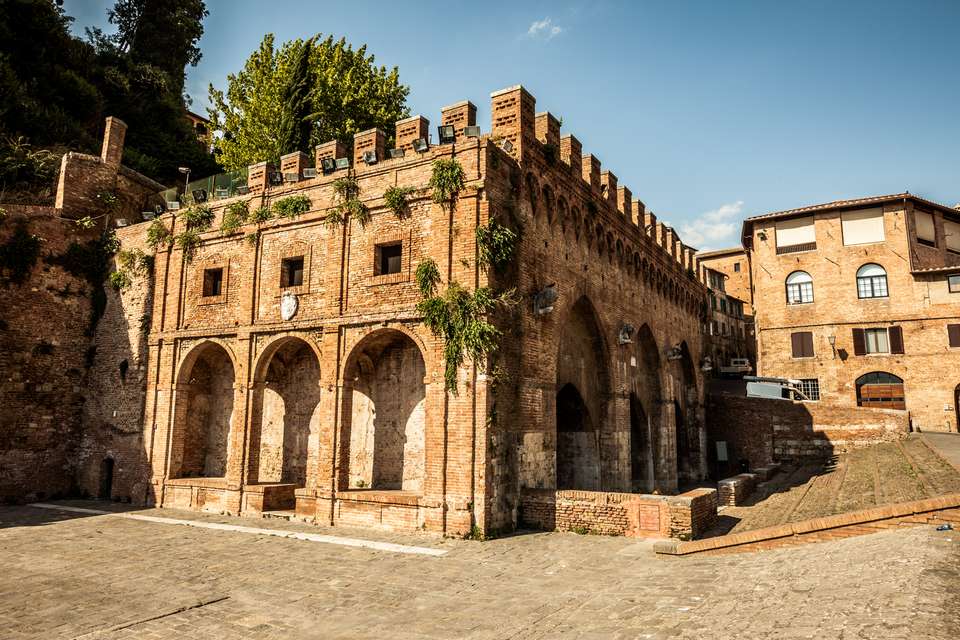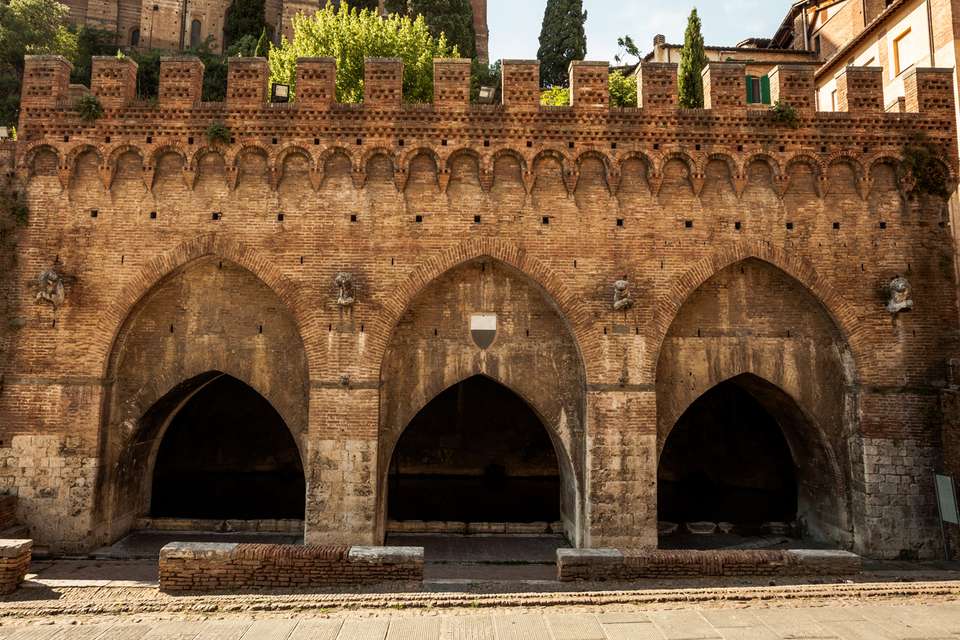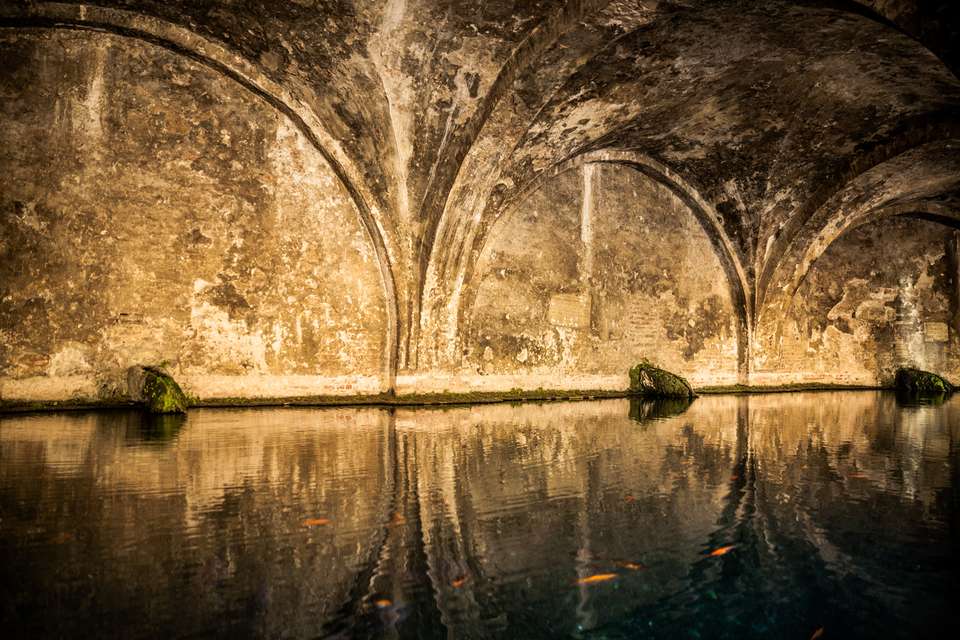





È la più famosa, monumentale e ricca d’acqua tra le fonti della città di Siena. La sua struttura è costituita da tre ampie arcate gotiche ogivali, sormontate da merli, aggiunti in epoca moderna; il prospetto è ornato da quattro figure leonine con al centro l’emblema civico di Siena, la “Balzana”, uno scudo diviso a metà in senso orizzontale, di colore bianco nella parte superiore e nero in quella inferiore. Originariamente la sua struttura era quella tipica delle fonti medievali: una prima vasca per l'acqua potabile, seguita da una seconda adibita ad abbeveratoio degli animali, oggi non più esistente, e una terza vasca utilizzata come lavatoio dei panni. La costruzione della prima arcata a copertura della vasca principale risale probabilmente al 1193, data riportata sulla lapide posta sull’interno, che ricorda come esecutore tal Bellamino. Tra il XIII e il XIV secolo la fonte fu ampliata con l’aggiunta di due ulteriori arcate a fianco della prima. Fontebranda è ricordata dal Boccaccio, da Fazio degli Uberti, da Leandro Alberti e forse anche dallo stesso Dante. Le sue acque giungevano dall'acquedotto sotterraneo (gli storici “bottini”) e proseguivano il proprio corso alimentando mulini, concerie e tintorie che si trovavano nella zona di Fontebranda, una delle quali apparteneva ai Benincasa, famiglia di Santa Caterina da Siena.
The most famous, the most monumental, the biggest and most important fountain of the city of Siena. The fountain is composed by: three wide ogival Gothic arches topped by merlons, added in modern time; front decorated by four leonine jets and, in the centre, the City's coat of arms called “balzana”, a shield divided in horizontal way, which is white above and black below. Originally the structure of the fountain is the typical one of medieval fountains: a first pool for drinking water, then a second one (now it doesn't exists anymore) as a watering hole for animals, and a third pool for washing clothes. The construction of the first arch to cover the main pool probably dates back to 1193, a date shown on the plaque on the inside, which recalls the Bellamino as executor. Between the thirteenth and fourteenth centuries the source was expanded with the addition of two additional arches alongside the first. Fontebranda is remembered by Boccaccio, by Fazio degli Uberti, by Leandro Alberti and perhaps also by Dante himself. The water arrived from the underground aqueduct of the "Bottini" and then still continued their course along canals that supplied mills, tanneries and dye-works, that were located indeed in the area of Fontebranda, one of which belonged to the Benincasa, family of Santa Caterina da Siena.
Der berühmteste, größte und wasserreichste Brunnen der Stadt. Seine Struktur besteht aus drei gotischen spitzbogigen Arkaden, mit Zinnen dekoriert, die in der Neuzeit hinzugefügt wurden; die Fassade ist mit vier Löwenkopf-Skulpturen verziert und in der Mitte hängt das Stadtwappen von Siena 'la Balzana', ein Wappen mit einer oberen weissen und unteren schwarzen Hälfte. Wie die typischen mittelalterlichen Brunnen, besteht der Fontebranda Brunnen aus drei Becken. Das erste Becken enthielt Trinkwasser, das zweite (heute nicht mehr sichtbar) diente als Viehtränke und das dritte wurde als Waschtrog benützt. Der Bau der ersten Arkade zur Überdachung des ersten Beckens stammt sehr warhscheinlich aus dem Jahr 1193, das Datum ist sichtbar auf dem einem Gedenkstein im inneren Raum, der an seinen Erbauer Bellamino erinnert. Zwischen dem XIII. und XIV. Jahrhundert wurde der Brunnen mit den anderen zwei Arkaden erweitert. Fontebranda wird von Bocaccio, Fazio degli Uberti, Leandro Alberti und vielleicht sogar von Dante erwähnt. Das Wasser kam aus dem unterirdischen Wasserleitungssystem (die historischen Bottini) und floss durch die Kanäle weiter bis zu Mühlen, Gerbereien und Färbereien (eine Färberei gehörte den Benincasa, der Familie der Heiligen Caterina aus Siena) in dem Gebiet des Fontebranda Brunnens.
Cette fontaine riche en eau est la plus célèbre et monumentale entre toutes les fontaines de la ville. Sa structure est constituée de trois amples arcs gothiques ogivaux, surmontés par des créneaux ajoutés en époque moderne; ornée par quatre figures léonines avec au centre le symbole de la “Balzana”, un bouclier divisé en deux dans le sens horizontal, de couleur blanche dans sa partie supérieure et de couleur noire dans sa partie inférieure. A l’origine sa structure était celle typique des fontaines médiévales: une première vasque pour l’eau potable, suivie par une seconde destinée aux animaux qui n’existe plus aujourd’hui et une troisième utilisée comme lavoir. La construction de la première arcade à couverture de la vasque principale remonte probablement à 1193, date reportée sur la plaque posée à l’intérieur, qui rappelle le nom de l’auteur Bellamino. Entre le XIIIe et le XIVe siècle la fontaine fut agrandie avec un ajout de deux ultérieures arcades à côté de la première. Fontebranda est rappelée par Boccaccio, par Fazio degli Uberti, par Leandro Alberti et peut être aussi par Dante. Ses eaux arrivaient par l’aqueduc souterrain (les fameux “bottini”) et continuaient leur parcours en alimentant les moulins, les tanneries et les teintureries qui se trouvaient à Fontebranda, dont une qui appartenait à la famille Benincasa, famille de Sainte Catherine de Sienne.
Es la más famosa, monumental y rica de agua entre las fuentes de la ciudad de Siena. Su estructura está constituida por tres amplios arcos góticos ojivales, coronados por almenas, agregados en época moderna; el prospecto está decorado por cuatro figuras de leones y en el centro el emblema cívico de Siena, la “Balzana”, un escudo dividido por la mitad en sentido horizontal, de color blanco en la parte superior y negro en la parte inferior. Originalmente su estructura era aquella típica de las fuentes medievales: la primera tina para el agua potable, seguida por una segunda usada como abrevadero para los animales, hoy ya no existe, y una tercera tina utilizada como lavandería para la ropa. La construcción del primer arco, el cual cubre la tina principal, probablemente es del 1193, fecha indicada en la placa colocada en la parte interior, que recuerda como ejecutor un tal Bellamino. Entre el siglo XIII y el siglo XIV la fuente fue ampliada aumentando dos arcos más junto al primero. Fontebranda es recordada por el Boccaccio, por Fazio degli Uberti, por Leandro Alberti y a lo mejor también por el mismo Dante. Sus aguas provenían desde el acueducto subterráneo (los históricos “bottini”) y proseguían su propio curso alimentando molinos, curtiembres y teñido que estaban ubicados en la zona de Fontebranda, una de las cuales pertenecía a los Benincasa, familia de Santa Catalina de Siena.

Luoghi
A few hours or even just one day is definitely not enough to discover Siena and experience it in all its aspects.
Thanks to a priceless historical and artistic heritage and to a rich net of commercial activities, Siena offers many cultural, entertainment and travel opportunities. Breathtaking views and hidden corners, confirmations and surprises await you behind every alley and in every square with unusual perspectives to be discovered also through the itineraries that we show you in this page.
The routes that vary according to the number of days, to your passions, to the season and to the will to either walk or rather relax in the city's green spaces. Many different ways to achieve a single objective: making your travel experience in our city unforgettable.
So, enjoy Siena! And thank you for spending your free time in our city.
We’ll always remain here, waiting for your next visit.



